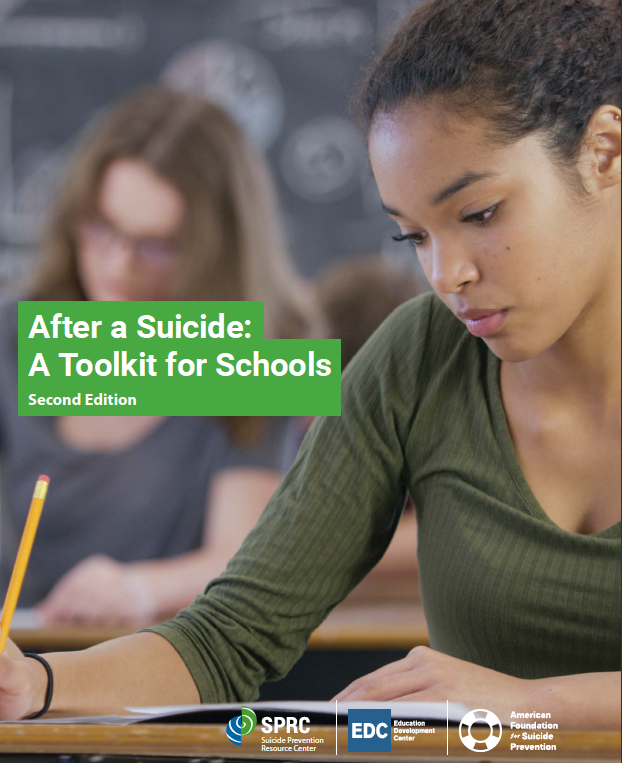 After a Suicide: A Toolkit for Schools was designed to help schools respond immediately in the minutes, hours, and days after a suicide as well as in the weeks and months it takes the school community to heal and move forward. Since significant numbers of high school-aged youth die by suicide across the United States every year, every school needs to be prepared to respond to such an event.
After a Suicide: A Toolkit for Schools was designed to help schools respond immediately in the minutes, hours, and days after a suicide as well as in the weeks and months it takes the school community to heal and move forward. Since significant numbers of high school-aged youth die by suicide across the United States every year, every school needs to be prepared to respond to such an event.
About the Toolkit
This toolkit reflects consensus recommendations developed in consultation with national experts, including school-based administrators and staff, clinicians, researchers, and crisis response professionals. It provides guidance and tools for postvention, a term used to describe activities that help people cope with the emotional distress resulting from a suicide and prevent additional trauma that could lead to further suicidal behavior and deaths, especially among people who are vulnerable.
This resource was developed primarily for administrators and staff in middle and high schools, but it can also be useful for parents and communities. Although some of the guidance can be used by schools serving other age groups, the developmental differences between students in elementary, middle, and high school, and college must be taken into account when using the toolkit to respond to a death in a school.
After a Suicide focuses on how to respond in the immediate aftermath of a suicide death of a student. Ideally, schools should have a crisis response and postvention plan in place before a suicide occurs. That will enable staff to respond in an organized and effective manner. But whether or not a school has such a plan, this toolkit contains information schools can use to initiate a coordinated response.
Toolkit Sections
The following are brief descriptions of the toolkit contents:
Crisis Response – Steps that should be taken immediately when the school learns that a student has died by suicide
Helping Students Cope – Ways that the school can help reduce the emotional trauma of an unexpected death for all students and reduce suicide risk among vulnerable students
Working with the Community – Approaches to sharing information and coordinating activities with organizations and groups outside the school, including the police department, local government, faith community, and mental health providers
Working with the Media – Helping journalists ensure that the public gets the information it needs without causing undue emotional stress, increasing the risk of contagion to other students, or violating the privacy of the deceased and his or her family
Memorialization – Appropriately remembering and honoring a student who died without contributing to additional emotional trauma or suicide risk among other students
Social Media – How to appropriately use social media to inform the community while working to limit the spread of rumors and social media content that can raise the risk of vulnerable students
Suicide Contagion – Helping vulnerable students who may be in emotional or suicidal crisis as a result of the death of another student, member of the school community, or a celebrity with whom they identify, in order to avoid additional suicidal behavior and deaths
Bringing in Outside Help – Identifying and working with postvention experts from outside the school
Going Forward – Moving past the immediate crisis and implementing a comprehensive suicide prevention plan (if the school does not already have one)
Appendix A: Tools and Templates – Sample guidelines, letters, and procedures to be used in the aftermath of a suicide
Appendix B: Additional Resources – Sources of more information and guidance on preparing for and responding to a suicide in the school community, listed by the section of the toolkit to which they are most relevant
Download the PDF of After a Suicide: A Toolkit for Schools. See the American Foundation for Suicide Prevention and Suicide Prevention Resource Center for additional resources.
This publication may be copied, reproduced, and distributed provided the copyright notice, author credit, and website addresses for both SPRC (sprc.org) and AFSP (afsp.org) are included.
Source: American Foundation for Suicide Prevention, & Suicide Prevention Resource Center | After a suicide: A toolkit for schools (2nd ed.), https://sprc.org/online-library/after-a-suicide-a-toolkit-for-schools-second-edition | © Education Development Center. Last revised 2022
A screening can help you determine if you or someone you care about should contact a mental health professional. Care Coordinators can arrange a free 30-minute Care Consultation so so you can explore options with an expert. Call or email our Care Coordinators at 650.688.3625 or careteam@stage.chconline.org to set up an initial Consultation appointment.





